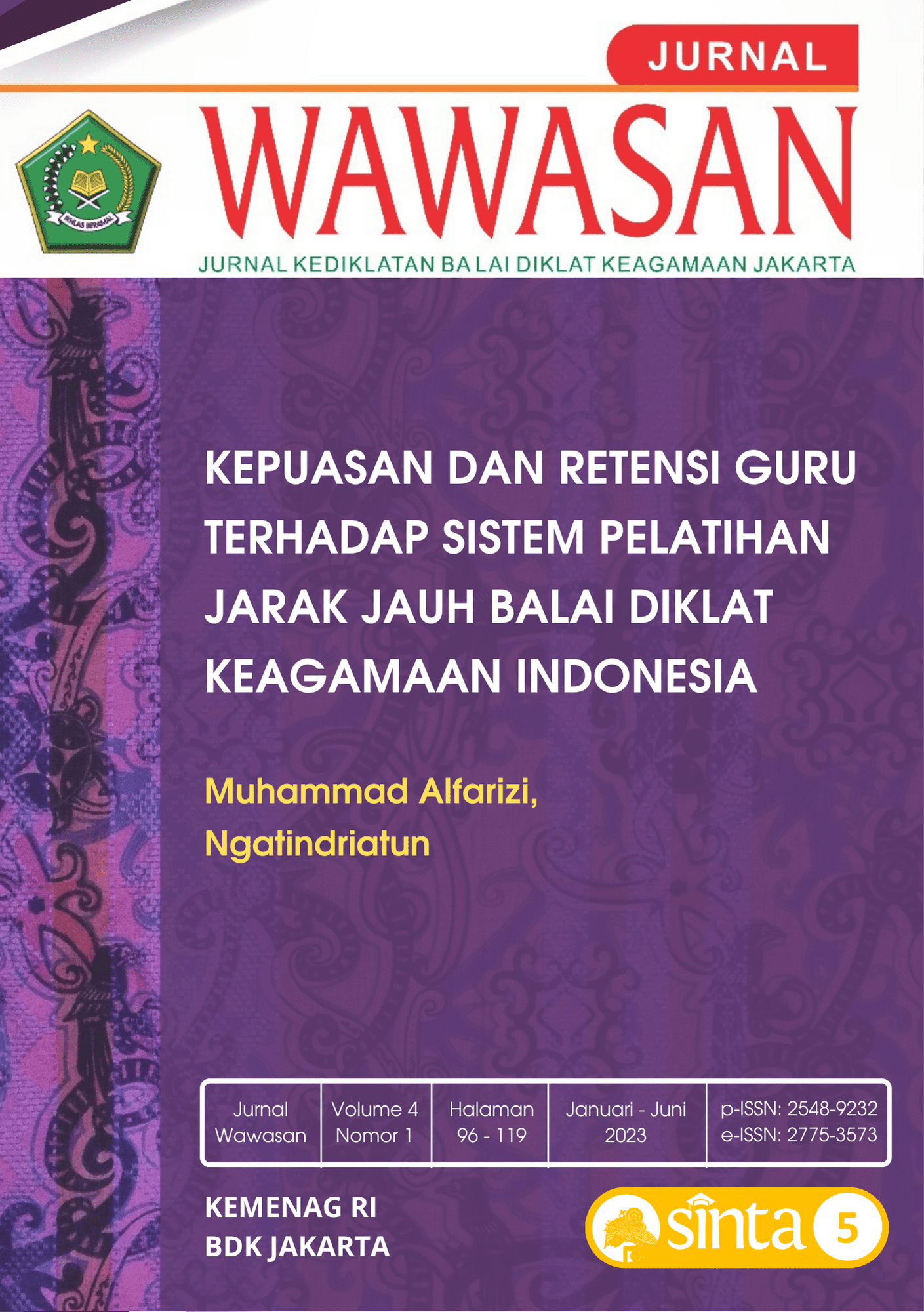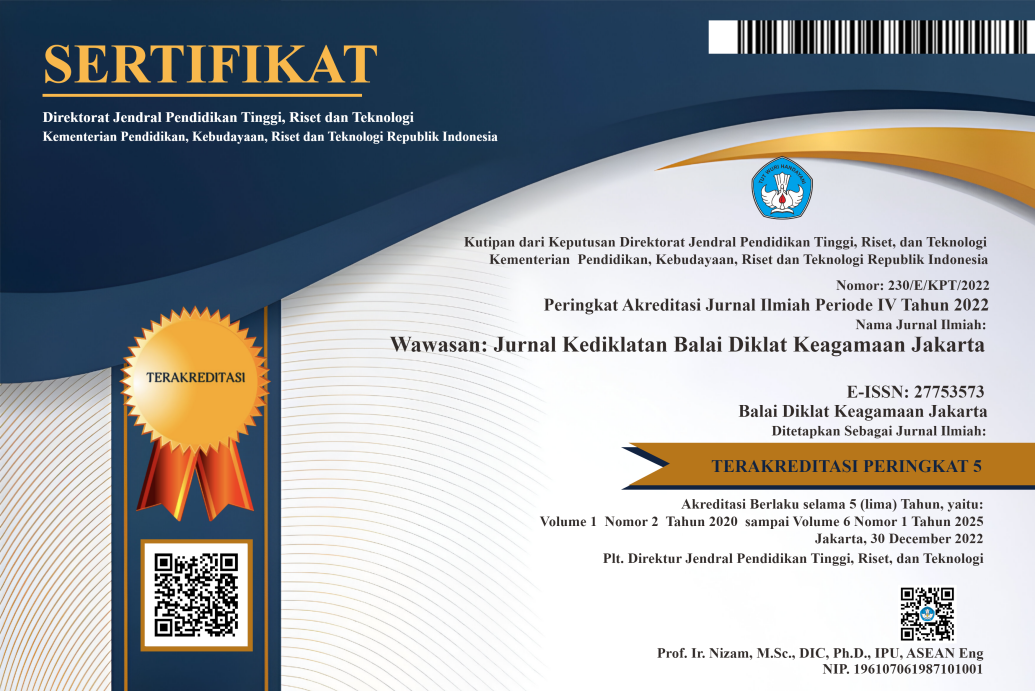KEPUASAN DAN RETENSI GURU TERHADAP SISTEM PELATIHAN JARAK JAUH BALAI DIKLAT KEAGAMAAN INDONESIA
DOI:
https://doi.org/10.53800/wawasan.v4i1.223Keywords:
E-Learning, retensi, pelatihan, model TAMAbstract
Abstract
Digital transformation after the COVID-19 Pandemic has touched the education sector through the development of e-learning. The use of e-learning media is not only for formal education learning but has also begun to feel the HR training department or directorate at state institutions. All ministries and state agencies in Indonesia must organize online education and training by utilizing e-learning. The BDK of the Ministry of Religion in Indonesia is very active in organizing distance education, especially for madrasa teachers, through the independent development e-learning platform for each BDK of the Ministry of Religion. This study is intended to investigate the factors driving satisfaction and retention of MoRA BDK distance training participants using e-learning. The study was carried out quantitatively based on a survey. It involved 206 madrasah teacher respondents who had attended the Ministry of Religion's BDK distance training or distance courses drawn by convenience sampling. This study found that cognitive uptake and social presence influence the perceived usefulness and ease of use of e-learning. In addition, this study determines that perceptions of the usefulness and ease of use of e-learning significantly influence satisfaction and, ultimately, electronic retention of MoRA BDK e-learning. This study recommends increasing system capability by combining utility and intrinsic features and developing a collaborative assignment system. The instructor's presence must be strengthened via live chat or video conference scheduling. The Ministry of Religion of the Republic of Indonesia needs to formulate a more detailed distance training policy, including appropriate training standards, to achieve the expected competencies of participants.
Abstrak
Transformasi digital pasca Pandemi COVID-19 menyentuh hingga sektor pendidikan melalui pengembangan e-learning. Pemanfaatan media e-learning tidak hanya untuk pembelajaran pendidikan formal, namun juga mulai menyentuh bagian atau direktorat pelatihan SDM pada lembaga negara. Saat ini seluruh kementerian dan lembaga negara di Indonesia dituntut menyelenggarakan pendidikan dan pelatihan secara online dengan memanfaatkan e-learning. BDK Kemenag di Indonesia sangat aktif menyelenggarakan pendidikan jarak jauh khususnya bagi guru madrasah melalui platform e-learning pengembangan mandiri masing-masing BDK Kemenag. Studi ini ditujukan untuk menginvestigasi faktor yang mendorong kepuasan dan retensi peserta pelatihan jarak jauh BDK Kemenag dalam menggunakan e-learning. Studi dilaksanakan secara kuantitatif berbasis survei dan melibatkan 206 responden guru madrasah yang pernah mengikuti pelatihan atau kursus jarak jauh BDK Kemenag yang ditarik dengan convenience sampling. Studi ini menemukan bahwa penyerapan kognitif dan kehadiran sosial memiliki pengaruh terhadap persepsi kegunaan dan kemudahan penggunaan e-learning. Selain itu studi ini menetapkan persepsi kegunaan dan kemudahan penggunaan e-learning secara signifikan mempengaruhi kepuasan dan pada ujungnya retensi elektronik kepada e-learning BDK Kemenag. Studi ini merekomendasikan peningkatakan kapabilitas sistem melalui penggabungan fitur utilitas dan intrinsik disertai pengembangan sistem kolaboratif penugasan. Kehadiran instruktur perlu diperkuat baik melalui fitur live chat ataupun penjadwalan video conference. Kementerian Agama RI perlu merumuskan kebijakan pelatihan jarak jauh yang lebih detail termasuk standar pelatihan yang sesuai agar kompetensi yang diharapkan pada peserta tercapai.
Downloads
References
Aburbeian, A. M., Owda, A. Y., & Owda, M. (2022). A Technology Acceptance Model Survey of the Metaverse Prospects. AI, 3(2), 285–302. https://doi.org/10.3390/ai3020018
Alfadda, H. A., & Mahdi, H. S. (2021). Measuring Students’ Use of Zoom Application in Language Course Based on the Technology Acceptance Model (TAM). Journal of Psycholinguistic Research, 50(4), 883–900. https://doi.org/10.1007/s10936-020-09752-1
Al‐hawari, M. A., & Mouakket, S. (2010). The influence of technology acceptance model (TAM) factors on students’ e‐satisfaction and e‐retention within the context of UAE e‐learning. Education, Business and Society: Contemporary Middle Eastern Issues, 3(4), 299–314. https://doi.org/10.1108/17537981011089596
Al-Nuaimi, M. N., & Al-Emran, M. (2021). Learning management systems and technology acceptance models: A systematic review. Education and Information Technologies, 26(5), 5499–5533. https://doi.org/10.1007/s10639-021-10513-3
Al-Salman, S., Haider, A. S., & Saed, H. (2022). The psychological impact of COVID-19’s e-learning digital tools on Jordanian university students’ well-being. The Journal of Mental Health Training, Education and Practice, 17(4), 342–354. https://doi.org/10.1108/JMHTEP-09-2021-0106
Becker, J.-M., Cheah, J.-H., Gholamzade, R., Ringle, C. M., & Sarstedt, M. (2023). PLS-SEM’s most wanted guidance. International Journal of Contemporary Hospitality Management, 35(1), 321–346. https://doi.org/10.1108/IJCHM-04-2022-0474
Boon-itt, S. (2015). Managing self-service technology service quality to enhance e-satisfaction. International Journal of Quality and Service Sciences, 7(4), 373–391. https://doi.org/10.1108/IJQSS-01-2015-0013
Cheung, R., & Vogel, D. (2013a). Predicting user acceptance of collaborative technologies: An extension of the technology acceptance model for e-learning. Computers & Education, 63, 160–175. https://doi.org/10.1016/j.compedu.2012.12.003
Cheung, R., & Vogel, D. (2013b). Predicting user acceptance of collaborative technologies: An extension of the technology acceptance model for e-learning. Computers & Education, 63, 160–175. https://doi.org/10.1016/j.compedu.2012.12.003
Chu, T.-H., & Chen, Y.-Y. (2016). With Good We Become Good: Understanding e-learning adoption by theory of planned behavior and group influences. Computers & Education, 92–93, 37–52. https://doi.org/10.1016/j.compedu.2015.09.013
Cinquin, P.-A., Guitton, P., & Sauzéon, H. (2019). Online e-learning and cognitive disabilities: A systematic review. Computers & Education, 130, 152–167. https://doi.org/10.1016/j.compedu.2018.12.004
Dash, G., & Paul, J. (2021). CB-SEM vs PLS-SEM methods for research in social sciences and technology forecasting. Technological Forecasting and Social Change, 173, 121092. https://doi.org/10.1016/j.techfore.2021.121092
Dror, I., Schmidt, P., & O’connor, L. (2011). A cognitive perspective on technology enhanced learning in medical training: Great opportunities, pitfalls and challenges. Medical Teacher, 33(4), 291–296. https://doi.org/10.3109/0142159X.2011.550970
Estriegana, R., Medina-Merodio, J.-A., & Barchino, R. (2019). Student acceptance of virtual laboratory and practical work: An extension of the technology acceptance model. Computers & Education, 135, 1–14. https://doi.org/10.1016/j.compedu.2019.02.010
Fauzi, A., Wandira, R., Sepri, D., & Hafid, A. (2021). Exploring Students’ Acceptance of Google Classroom during the COVID-19 Pandemic by Using the Technology Acceptance Model in West Sumatera Universities. Electronic Journal of E-Learning, 19(4), 233–240.
Girish, V. G., Kim, M.-Y., Sharma, I., & Lee, C.-K. (2022a). Examining the structural relationships among e-learning interactivity, uncertainty avoidance, and perceived risks of COVID-19: Applying extended technology acceptance model. International Journal of Human–Computer Interaction, 38(8), 742–752. https://doi.org/10.1080/10447318.2021.1970430
Girish, V. G., Kim, M.-Y., Sharma, I., & Lee, C.-K. (2022b). Examining the structural relationships among e-learning interactivity, uncertainty avoidance, and perceived risks of COVID-19: Applying extended technology acceptance model. International Journal of Human–Computer Interaction, 38(8), 742–752. https://doi.org/10.1080/10447318.2021.1970430
Granić, A., & Marangunić, N. (2019). Technology acceptance model in educational context: A systematic literature review. British Journal of Educational Technology, 50(5), 2572–2593. https://doi.org/10.1111/bjet.12864
Hair, J., & Alamer, A. (2022). Partial Least Squares Structural Equation Modeling (PLS-SEM) in second language and education research: Guidelines using an applied example. Research Methods in Applied Linguistics, 1(3), 100027. https://doi.org/10.1016/j.rmal.2022.100027
Headar, M. M., Elaref, N., & Yacout, O. M. (2013). Antecedents and Consequences of Student Satisfaction with e-Learning: The Case of Private Universities in Egypt. Journal of Marketing for Higher Education, 23(2), 226–257. https://doi.org/10.1080/08841241.2013.867919
Hsia, J.-W., Chang, C.-C., & Tseng, A.-H. (2014). Effects of individuals’ locus of control and computer self-efficacy on their e-learning acceptance in high-tech companies. Behaviour & Information Technology, 33(1), 51–64. https://doi.org/10.1080/0144929X.2012.702284
Hu, P. J., Chau, P. Y. K., Liu Sheng, O. R., & Tam, K. Y. (1999). Examining the Technology Acceptance Model Using Physician Acceptance of Telemedicine Technology. Journal of Management Information Systems, 16(2), 91–112. https://doi.org/10.1080/07421222.1999.11518247
Huang, T.-H., Liu, F., Chen, L.-C., & Tsai, C.-C. (2021). The acceptance and impact of Google Classroom integrating into a clinical pathology course for nursing students: A technology acceptance model approach. PLOS ONE, 16(3), e0247819. https://doi.org/10.1371/journal.pone.0247819
Ilgaz, H., & Gülbahar, Y. (2015). A snapshot of online learners: e-Readiness, e-Satisfaction and expectations. The International Review of Research in Open and Distributed Learning, 16(2). https://doi.org/10.19173/irrodl.v16i2.2117
Indriati, F., & Agustina, P. (2018). The influence of UTAUT factors on E-retention with E-satisfaction as mediating variable in E-learning. Hasanuddin Economics and Business Review, 2(1), 19–33.
Jalal, A., & Mahmood, M. (2019). Students’ behavior mining in e-learning environment using cognitive processes with information technologies. Education and Information Technologies, 24(5), 2797–2821. https://doi.org/10.1007/s10639-019-09892-5
Kelders, S. M., van Zyl, L. E., & Ludden, G. D. S. (2020). The Concept and Components of Engagement in Different Domains Applied to eHealth: A Systematic Scoping Review. Frontiers in Psychology, 11. https://doi.org/10.3389/fpsyg.2020.00926
Kemp, A., Palmer, E., & Strelan, P. (2019). A taxonomy of factors affecting attitudes towards educational technologies for use with technology acceptance models. British Journal of Educational Technology, 50(5), 2394–2413. https://doi.org/10.1111/bjet.12833
Kong, S.-C. (2021). Delivery and evaluation of an e-Learning framework through computer-aided analysis of learners’ reflection text in a teacher development course. Research and Practice in Technology Enhanced Learning, 16(1), 28. https://doi.org/10.1186/s41039-021-00172-w
Konstantinidis, Kl., Apostolakis, I., & Karaiskos, P. (2022). A narrative review of e-learning in professional education of healthcare professionals in medical imaging and radiation therapy. Radiography, 28(2), 565–570. https://doi.org/10.1016/j.radi.2021.12.002
Liao, Y.-K., Wu, W.-Y., Le, T. Q., & Phung, T. T. T. (2022). The Integration of the Technology Acceptance Model and Value-Based Adoption Model to Study the Adoption of E-Learning: The Moderating Role of e-WOM. Sustainability, 14(2), 815. https://doi.org/10.3390/su14020815
Mehta, A., Morris, N. P., Swinnerton, B., & Homer, M. (2019). The Influence of Values on E-learning Adoption. Computers & Education, 141, 103617. https://doi.org/10.1016/j.compedu.2019.103617
Mishra, V. K. (2021). An overview on cognitive load theory and concepts of human-computer interaction. Asian Journal of Multidimensional Research, 10(12), 591–597.
Natasia, S. R., Wiranti, Y. T., & Parastika, A. (2022). Acceptance analysis of NUADU as e-learning platform using the Technology Acceptance Model (TAM) approach. Procedia Computer Science, 197, 512–520. https://doi.org/10.1016/j.procs.2021.12.168
Nugraha, F., Restendi, D., & Triyanto, A. (2020). Pengembangan sistem pelatihan jarak jauh berbasis moodle di Balai Diklat Keagamaan Bandung. Andragogi: Jurnal Diklat Teknis Pendidikan Dan Keagamaan, 8(2), 540.
Opoku, D. (2020). Determinants of e-learning system adoption among ghanaian university lecturers: An application of information system success and technology acceptance models. American Journal of Social Sciences and Humanities, 5(1), 151–168.
Oyman, M., Bal, D., & Ozer, S. (2022). Extending the technology acceptance model to explain how perceived augmented reality affects consumers’ perceptions. Computers in Human Behavior, 128, 107127. https://doi.org/10.1016/j.chb.2021.107127
Pal, D., & Vanijja, V. (2020). Perceived usability evaluation of Microsoft Teams as an online learning platform during COVID-19 using system usability scale and technology acceptance model in India. Children and Youth Services Review, 119, 105535. https://doi.org/10.1016/j.childyouth.2020.105535
Persico, D., Manca, S., & Pozzi, F. (2014). Adapting the Technology Acceptance Model to evaluate the innovative potential of e-learning systems. Computers in Human Behavior, 30, 614–622. https://doi.org/10.1016/j.chb.2013.07.045
Pinho, C., Franco, M., & Mendes, L. (2021). Application of innovation diffusion theory to the E-learning process: higher education context. Education and Information Technologies, 26(1), 421–440. https://doi.org/10.1007/s10639-020-10269-2
Pituch, K. A., & Lee, Y. (2006). The influence of system characteristics on e-learning use. Computers & Education, 47(2), 222–244. https://doi.org/10.1016/j.compedu.2004.10.007
Prasetyo, Y. T., Ong, A. K. S., Concepcion, G. K. F., Navata, F. M. B., Robles, R. A. v., Tomagos, I. J. T., Young, M. N., Diaz, J. F. T., Nadlifatin, R., & Redi, A. A. N. P. (2021). Determining Factors Affecting Acceptance of E-Learning Platforms during the COVID-19 Pandemic: Integrating Extended Technology Acceptance Model and DeLone & McLean IS Success Model. Sustainability, 13(15), 8365. https://doi.org/10.3390/su13158365
Rahman, M. A., Amarullah, R., & Hidayah, K. (2020). Evaluasi Penerapan Model Pembelajaran E-Learning pada Pelatihan Dasar Calon Pegawai Negeri Sipil. Jurnal Borneo Administrator, 16(1), 101–116. https://doi.org/10.24258/jba.v16i1.656
Rahmawati, R. N. (2019). Self-efficacy and use of e-learning: A theoretical review technology acceptance model (TAM). American Journal of Humanities and Social Sciences Research, 3(5), 41–55.
Rahmawati, R. N., & Narsa, I. M. (2019). Penggunaan e-learning dengan Technology Acceptance Model (TAM). Jurnal Inovasi Teknologi Pendidikan, 6(2), 127–136.
Raspopovic, M., & Jankulovic, A. (2017). Performance measurement of e-learning using student satisfaction analysis. Information Systems Frontiers, 19(4), 869–880. https://doi.org/10.1007/S10796-016-9636-Z/TABLES/8
Revythi, A., & Tselios, N. (2019a). Extension of technology acceptance model by using system usability scale to assess behavioral intention to use e-learning. Education and Information Technologies, 24(4), 2341–2355. https://doi.org/10.1007/s10639-019-09869-4
Revythi, A., & Tselios, N. (2019b). Extension of technology acceptance model by using system usability scale to assess behavioral intention to use e-learning. Education and Information Technologies, 24(4), 2341–2355. https://doi.org/10.1007/s10639-019-09869-4
Saade, R., & Kira, D. (2009). Computer Anxiety in E-Learning: The Effect of Computer Self-Efficacy. Proceedings of the 2009 InSITE Conference, 8. https://doi.org/10.28945/3386
Salimon, M. G., Sanuri, S. M. M., Aliyu, O. A., Perumal, S., & Yusr, M. M. (2021a). E-learning satisfaction and retention: a concurrent perspective of cognitive absorption, perceived social presence and technology acceptance model. Journal of Systems and Information Technology, 23(1), 109–129. https://doi.org/10.1108/JSIT-02-2020-0029
Salimon, M. G., Sanuri, S. M. M., Aliyu, O. A., Perumal, S., & Yusr, M. M. (2021b). E-learning satisfaction and retention: a concurrent perspective of cognitive absorption, perceived social presence and technology acceptance model. Journal of Systems and Information Technology, 23(1), 109–129. https://doi.org/10.1108/JSIT-02-2020-0029
Salloum, S. A., Qasim Mohammad Alhamad, A., Al-Emran, M., Abdel Monem, A., & Shaalan, K. (2019). Exploring Students’ Acceptance of E-Learning Through the Development of a Comprehensive Technology Acceptance Model. IEEE Access, 7, 128445–128462. https://doi.org/10.1109/ACCESS.2019.2939467
Setiyani, L., Effendy, F., & Slamet, A. A. (2021). Using Technology Acceptance Model 3 (TAM 3) at selected private technical high school: google drive storage in e-learning. Utamax: Journal of Ultimate Research and Trends in Education, 3(2), 80–89.
Silva, P. (2015). Davis’ technology acceptance model (TAM)(1989). Information Seeking Behavior and Technology Adoption: Theories and Trends, 205–219.
Sukendro, S., Habibi, A., Khaeruddin, K., Indrayana, B., Syahruddin, S., Makadada, F. A., & Hakim, H. (2020). Using an extended Technology Acceptance Model to understand students’ use of e-learning during Covid-19: Indonesian sport science education context. Heliyon, 6(11), e05410. https://doi.org/10.1016/j.heliyon.2020.e05410
Tarhini, A., Hone, K., Liu, X., & Tarhini, T. (2017). Examining the moderating effect of individual-level cultural values on users’ acceptance of E-learning in developing countries: a structural equation modeling of an extended technology acceptance model. Interactive Learning Environments, 25(3), 306–328. https://doi.org/10.1080/10494820.2015.1122635
Wong, A., Leahy, W., Marcus, N., & Sweller, J. (2012a). Cognitive load theory, the transient information effect and e-learning. Learning and Instruction, 22(6), 449–457. https://doi.org/10.1016/j.learninstruc.2012.05.004
Wong, A., Leahy, W., Marcus, N., & Sweller, J. (2012b). Cognitive load theory, the transient information effect and e-learning. Learning and Instruction, 22(6), 449–457. https://doi.org/10.1016/j.learninstruc.2012.05.004
Wong, W. P.-M., Lo, M.-C., & Ramayah, T. (2014). The effects of technology acceptance factors on customer e-loyalty and e-satisfaction in Malaysia. International Journal of Business and Society, 15(3), 477.
Wu, C.-C., & Hsu, C.-L. (2015). How to Improve E-Satisfaction and E-Loyalty and Strengthen the Links Between Them: Value From Regulatory Fit. Human Factors and Ergonomics in Manufacturing & Service Industries, 25(3), 353–369. https://doi.org/10.1002/hfm.20549
Zardari, B. A., Hussain, Z., Arain, A. A., Rizvi, W. H., & Vighio, M. S. (2021). Development and Validation of User Experience-Based E-Learning Acceptance Model for Sustainable Higher Education. Sustainability, 13(11), 6201. https://doi.org/10.3390/su13116201

Published
Issue
Section
License
Copyright (c) 2023 Wawasan: Jurnal Kediklatan Balai Diklat Keagamaan Jakarta

This work is licensed under a Creative Commons Attribution-ShareAlike 4.0 International License.

















